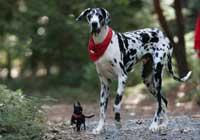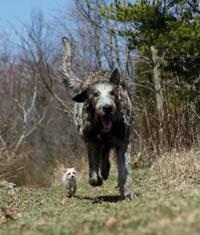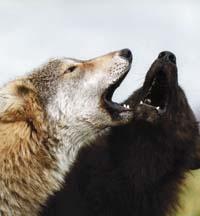The small dog, big in its smallness
2007/05/06 Rementeria Argote, Nagore - Elhuyar Zientziaren Komunikazioa

The way genomics work is basically simple: Know and compare DNA sequences as accurately as possible. This is what they have done to know the difference between older and small dogs, sequencing and comparing the DNA of small and older dogs. Of course, as usually happens in this type of research, although the explanation is simple, the back work has not been slow.
The research began with some Portuguese water dogs, almost by chance. The case is that one of the researchers died the dog, geneticist Gordon Lark of the University of Utah. He picked up the dog in the street and together they took years. At first, Lark thought the dog did not have a certain breed, but later he discovered it was a Portuguese aquatic dog. After his death, he begins to look for a dog of the same breed and meets a woman who grew dogs of water. This woman gave him a breed aquatic dog that, in return, heated to genetically investigate. He turns to the subject and realizes that the aquatic dog was very appropriate to investigate the size of the dogs, since, on the one hand, even if they are of the same breed, they are of very different size and, on the other, all the Portuguese water dogs come from a few ancestors.
Working with thousands of dogs

Even if it seems a lie, those of the image are adult animals of the same species, Canis familiaris , dogs: the one on the left is Zoie, standing by shoulder only 17 cm, and the one on the right is the great Danish Gibson, the highest dog in the world, 107 cm of foot to shoulder and 213 cm of foot! (Photo: © Deanne Fitzmaurice)
Thus began genetic research of the size of dogs. Larke formed a large research group that began with her colleagues at the University of Utah and later joined other universities. And they had the help of the owners of aquatic dogs, who received blood samples and x-rays of hundreds of aquatic dogs. We performed DNA analysis and compared each other.
The comparison made it quite clear that there was a gene directly related to size. In view of this, they extended research to other canine races. Samples of dogs of various sizes, of more than three thousand dogs were collected: Chihuahua Ñimiños, owners of San Bernardo, caniches, pecídeas, great Danish, Irish hunting dogs, etc. In total, one hundred and forty-three races. And they saw that all small dogs have the same variety as the gene. Therefore, in this gene is the key to the childhood of dogs.

They also studied the antiquity of this variant of the gene. And it is not today in the morning, but this variant was born shortly after the man tamed the wolf, about twelve thousand years ago. Most wolves have a similar size, their small size does not give advantages to the wolf in the wild life, but yes to the dog near the man. The men and women of the time would have seen that small dogs were suitable for certain activities and would grow to small dogs.
Of these small races emerged today: Chihuahua, beijing, caniche, etc. Who had to say that the main difference between a Chihuahua that does not reach the kilo and a robust shepherd over a hundred kilos was a gene.
Published in 7K.

Gai honi buruzko eduki gehiago
Elhuyarrek garatutako teknologia






